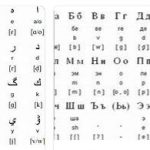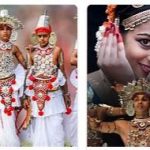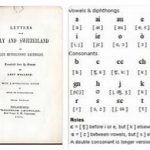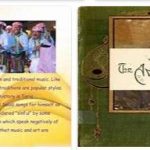Culture
In pre- Hispanic times, the Muisca (around 1200–1540) settled the highlands of Bogotá and developed a high culture whose rites the legend of the golden land of Eldorado refers to. The artistic gold work of the Muisca includes human figures, snakes or spear throwers, as well as scenic representations. These pre-Columbian works of art can be seen today in the Gold Museum in Bogotá. When the Spaniards discovered the country in 1499, they named it New Granada. It was only later that Colombia was given its current name in honor of the discoverer of America, C. Columbus . The cultural, especially architectural, legacy of the Spanish conquerors is still in the old towns of Bogotá, Cartagena and Popayán lively. Cobblestone plazas, cathedrals in the style of neoclasicismo, alleys with white houses and enchanted patios transport the strollers back to 18th century Andalusia.
The most famous representative of contemporary Colombian art is the painter and sculptor F. Botero . His paintings and sculptures, which were influenced by the colonial baroque, Mexican muralism and pre-Columbian art, are characterized by thick figures, almost caricatured, and balloon-like objects in bright colors.
The most important writer in Colombia is the Nobel Prize laureate G. García Márquez , who became world famous for his novels ” Hundred Years of Solitude ” (1967) and ” Love in the Times of Cholera ” (1985). These works, in which reality and fantasy flow into one another, drew attention to the living conditions in Colombia and initiated the boom in Latin American literature. Another well-known representative of Colombian literature is Á. Mutis , who became known to an international reading public primarily through his novels about the adventurer and navigator Maqroll El Gaviero. Colombia has a lively literary, theater and film scene with annual festivals in Medellín, Bogotá and Cartagena.
Latin American music and dances are just as diverse as the ethnic groups and their cultures. While Vallenato and Cumbia with African-influenced rhythms dominate the Caribbean coast, Cali is the salsa stronghold. Merengue is also common throughout the country. Internationally known are the musicians Carlos Vives (* 1961) with his mixture of Vallenato sounds and rock and the singer and guitarist Juanes (* 1972) who campaigns against violence in Colombia in his songs. Of the numerous festivals, the Easter processions of Popayán as well as the “Carnaval de Barranquilla” and the “Carnaval de Blancos y Negros” are best known. The most popular sport is soccer. But cycling races are also popular; In 2019, Egan Bernal (* 1997) became the first Colombian to win the Tour de France. The Tejo sport emerged from a 500 year old Indian game of skill called Turmequé. In 2000, Tejo was declared the official national sport of Colombia by parliament.
World Heritage Sites in Colombia
World Heritage Sites (K) and World Natural Heritage Sites (N)
- Port, fortifications and monuments of the colonial era in Cartagena (K; 1984)
- Los Katios National Park (N; 1994)
- Old town of Mompós (K; 1995)
- Tierradentro Archaeological Park (K; 1995)
- San Augustín Archaeological Park (K; 1995)
- Malpelo Nature Reserve (N; 2006)
- Great Inca Road » Qhapaq Ñan « in the Andes (K; 2014)
- Chiribiquete National Park (C / N; 2018)
Colombian literature
Colombian literature, term for the literature of Colombia, which is part of Latin American literature in the Spanish language.
According to computerannals, the beginning of Colombian literature is set with the historical-polemical work »Antijovio« (written in 1569, published in 1952) by the conquistador G. Jiménez de Quesada. Juan de Castellanos (* 1522, † 1607) earned the title of “Colombian Homer” with a 150,000-verse rhyming chronicle of the Conquista and colonization. The most important work of colonial literature in Colombia is the satirical chronicle “El carnero” (written around 1636, published in 1859) by Juan Rodríguez Freile (* 1566, † 1640 [?]), Which appears in numerous “unheard of” anecdotes (about murder and manslaughter in connection with love affairs) draws a picture of the colonial times in »Nueva Granada« and particularly emphasizes the »sinister« role of women.
The poetry of José Joaquín Ortiz (* 1814, † 1892), Julio Arboleda (* 1817, † 1862) and especially José Eusebio Caro (* 1817, † 1853) ushered in Romanticism, that of Rafael Pombo (* 1833, † 1912), R. Núñez and Miguel Antonio Caro (* 1843, † 1909). The latter and Rufino José Cuervo (* 1844, † 1911) are considered the most important philologists of their time for the entire Spanish-speaking area. The romantic novel “María” (1867) by J. Isaacs, the idyllic description of the landscape with the theme of unhappy love in style, found widespread distribution throughout Latin America J. H. Saint-Pierres connects.
The main exponents of modernism were J. A. Silva, Guillermo Valencia (* 1873, † 1943) and, in a very idiosyncratic manner, Luis Carlos López (* 1883, † 1950) and the novelist José María Vargas Vila (* 1860, † 1933). In addition, the naturalistically influenced works by T. Carrasquilla and the jungle novel “La vorágine” (1924) by J. E. Rivera gained continental importance. Avant-garde tendencies prevailed with the works of León de Greiff (* 1895, † 1976) and Jorge Zalamea (* 1905, † 1969).
The Colombian literature, which was largely shaped by aesthetic formalism, experienced a stronger political influence during the civil war of 1948–58. a. in the variant of the Atlantic coast, which sought to set itself apart from the literature of the highlands and thus the capital Bogotá, especially with its most prominent representative G. García Márquez. The problems of the big city presence increasingly came into focus, for example in the experimental novels by Oscar Collazos (* 1942, † 2015). In contrast, Á. Mutis has his own global dream world with his »Maqroll« cycle.
The late avant-garde nihilism of the Nadaísmo school was overcome by young poets such as Juan Gustavo Cobo-Borda (* 1948).
In the mid-1980s, the experimental, politically committed theater achieved significant achievements, including: the groups around Carlos José Reyes (* 1941), Santiago García (* 1927) and Miguel Torres. In the 1990s, the poet Jaime García Maffla (* 1944) became known, in the prose Fanny Buitrago (* 1946), Eduardo Escobar (* 1943), Luis Fayad (* 1945) appeared. Other important representatives of contemporary Colombian literature include: F. Vallejo , T. González, JG Vásquez and J. Paredeswho shed light on topics such as illness and violence or aspects of the life and psyche of their protagonists in their novels and stories that do not relate solely to the social reality of their home country.
So far, a Colombian writer has received the Nobel Prize for Literature: G. García Márquez (1982).









